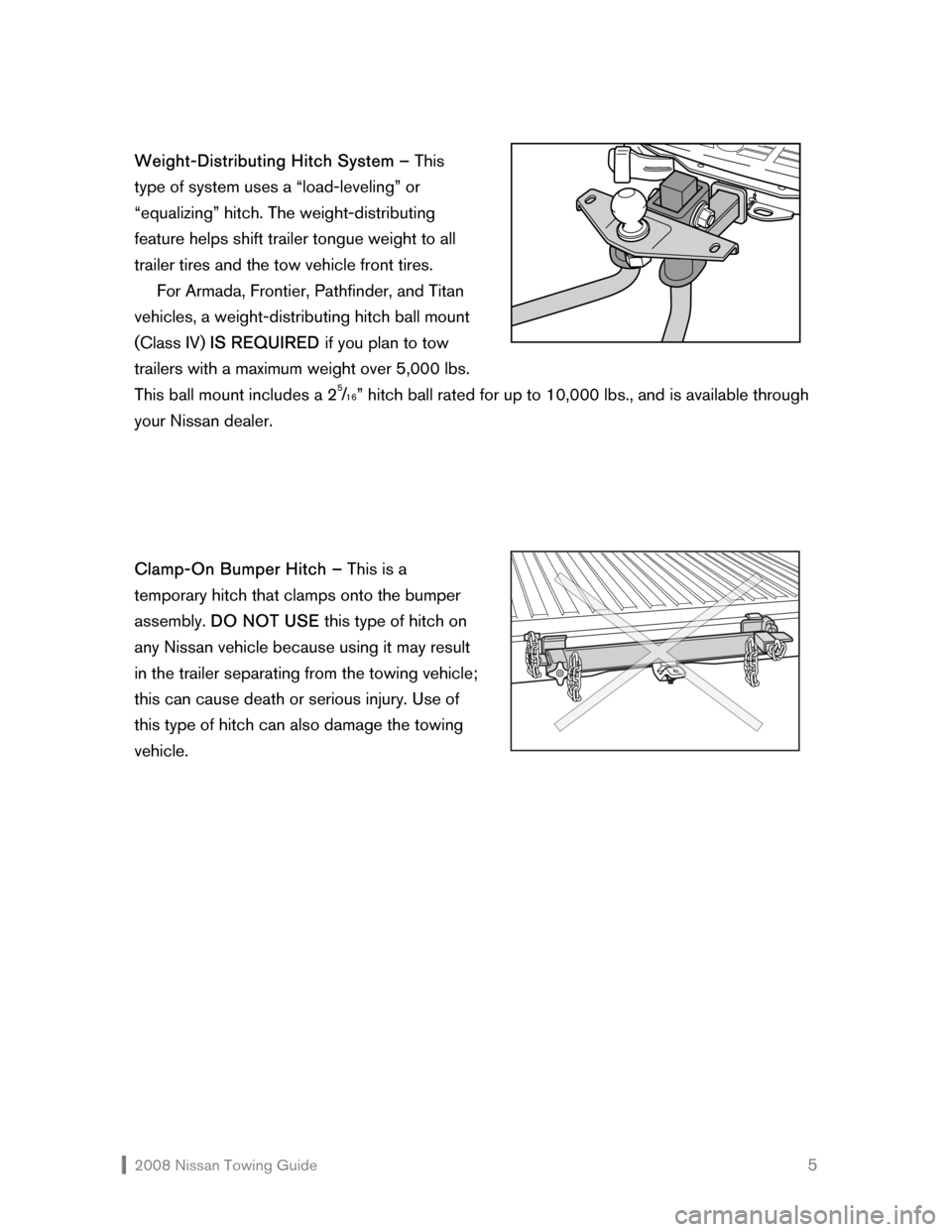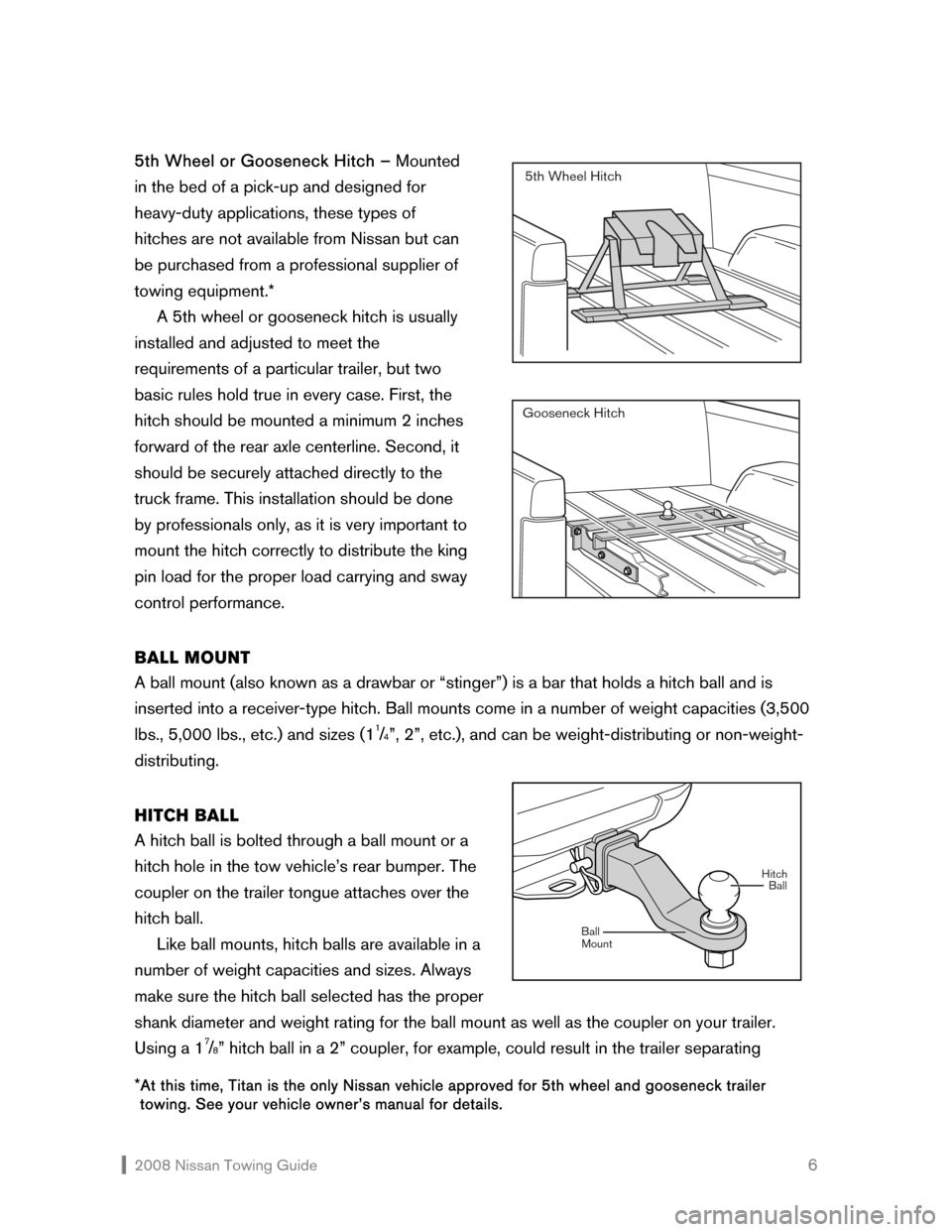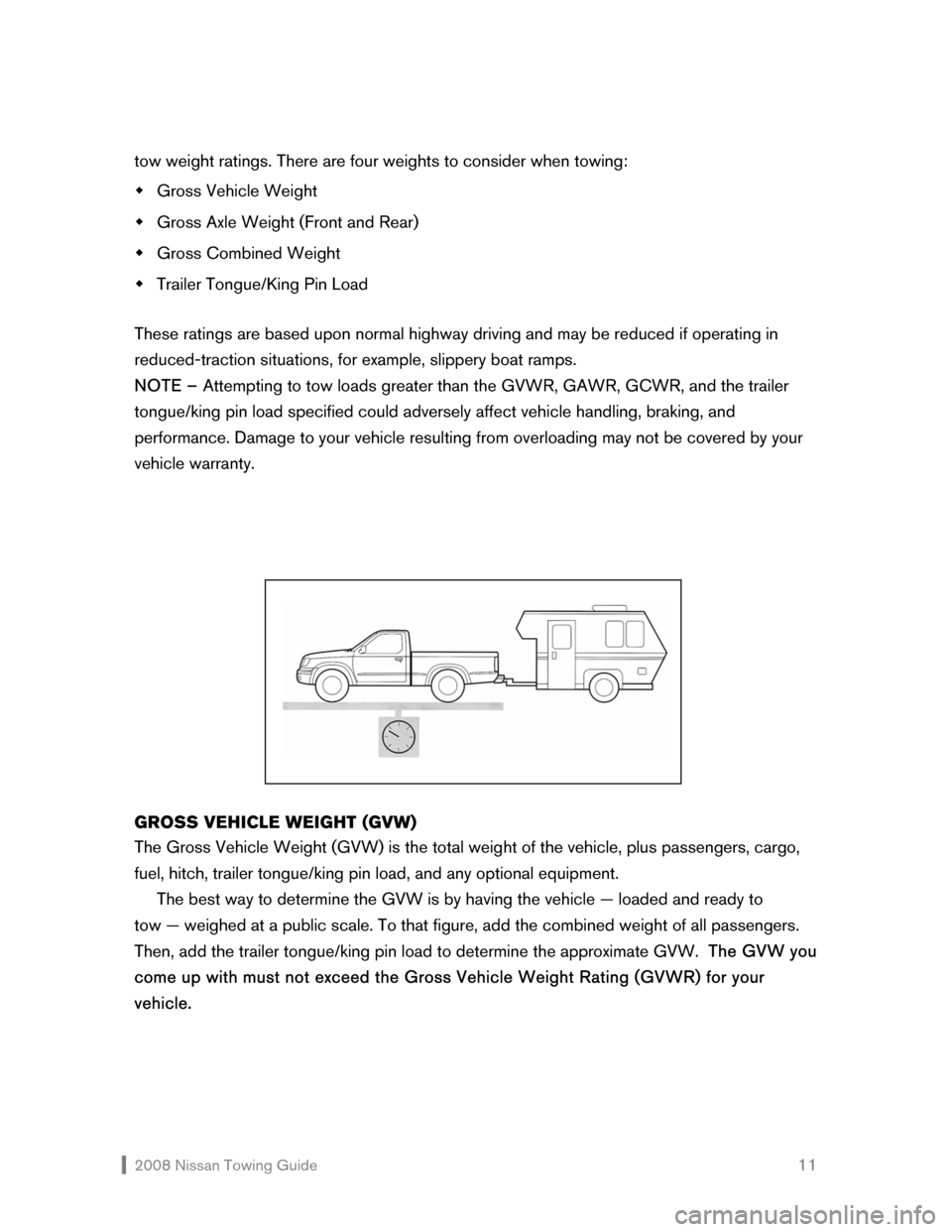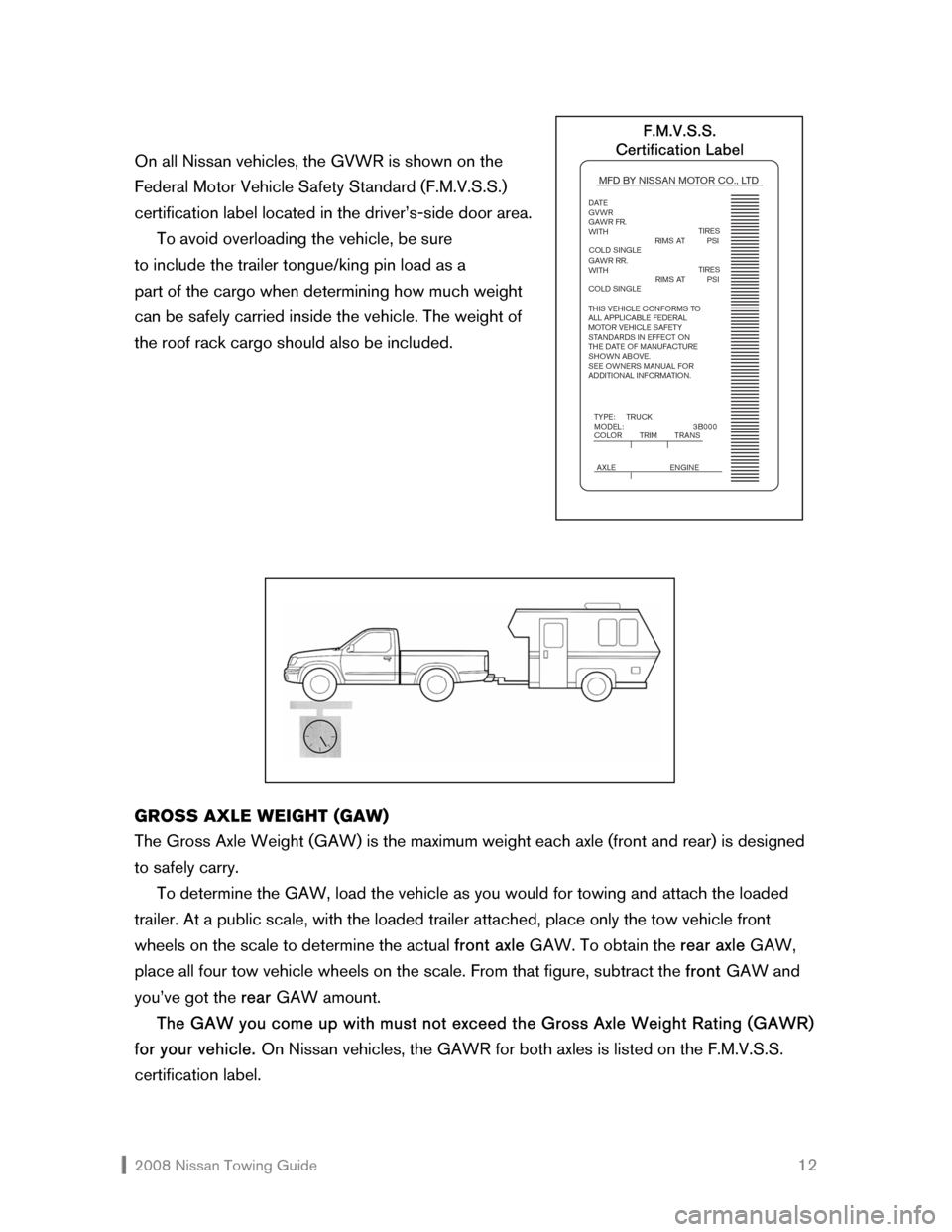2008 NISSAN XTERRA weight
[x] Cancel search: weightPage 3 of 32

2008 Nissan Towing Guide 2 Finally, there are state and local laws on towing that you should review to ensure compliance
with all regulations.
TOWING
EQUIPMENT
RENTING
The first thing to keep in mind when renting a trailer is to rent only from professional
companies that specialize in towing and towing equipment. More than likely, specialized
companies hire professional staff that can assist you in selecting and installing the proper
towing equipment for your Nissan vehicle.
When renting, make sure you have your vehicle owner’s manual on hand so that you can
reference the towing capacities for your specific vehicle. Never rent a trailer that exceeds
these capacities, and make sure that any related towing equipment you rent will be sufficient
for the loaded trailer.
While you’re there, ask questions. How much does the empty trailer weigh? How much
weight will the trailer hold? What is the trailer’s tongue load? With what type of brakes is it
equipped (if any)? All of these factors have an effect on whether your Nissan vehicle is
capable of safely pulling that type of trailer or piece of equipment.
Make certain that all of the trailer stoplights, taillights, and turn signals are connected and
are operating correctly, and that all safety equipments are properly installed. Check the safety
chains/cables, tie-downs, etc.
For safer operation, carefully inspect the condition of the trailer and towing equipment.
Specifically, check to make sure the tires are not worn excessively and are properly inflated.
Make sure there are not any broken welds, missing bolts, and that the hitch components are
not damaged.
Towing safety should be a high priority when choosing and renting towing equipment,
including hitches. NEVER RENT A CLAMP-ON-TYPE HITCH. Your vehicle’s bumpers are
not designed for using this type of hitch. Using it will damage your vehicle and could even
result in the trailer separating from the towing vehicle; this can cause death or serious injury.
To avoid this, use only a permanent-type hitch.
PURCHASING
If you are buying a travel or boat trailer, be sure that your Nissan vehicle has the towing
capacity to pull it. See the SPECIFICATIONS section of this guide or refer to your vehicle
owner’s manual for detailed information regarding the towing capacity of your specific vehicle.
Page 4 of 32

2008 Nissan Towing Guide 3 Your vehicle owner’s manual should ALWAYS be referenced before making any towing
decisions.
Naturally, you will want to buy the highest-quality equipment you can find for maximum
towing safety. And if you plan to tow often, consider convenience. Quick-disconnect trailer
light connectors and ratchet-type tie-downs, for example, make the job go faster and easier
and are usually worth the extra small investment. Purchase towing items such as hitches and
hitch balls only from your Nissan dealer or a professional supplier of towing equipment.
If you are intending to use your vehicle to tow a trailer you already own, you must ensure
that your loaded trailer remains well within your vehicle's towing capacity as specified in the
vehicle owner's manual. In addition, you should purchase the right type, style, and class* of
hitch and towing equipment to properly adapt the trailer to your vehicle.
WHAT’S
RIGHT FOR YOU
TYPES OF EQUIPMENT
Towing requires a variety of equipment, and, depending upon the application, there can be
several types or styles of each piece of equipment. Working with your Nissan dealer or a
professional supplier of towing equipment, it should be relatively simple to determine the
proper type of equipment for your specific vehicle given the intended application. This section
explains the most common pieces of towing equipment available.
HITCHES
Whichever type of hitch you use, it should be firmly bolted to your vehicle, and should be of
the appropriate weight class for the equipment you intend to tow. In addition, keep the
following in mind:
�Š Do not modify the vehicle’s braking or exhaust systems or its body structure/frame when
installing the hitch.
�Š Be sure that the hitch does not interfere in any way with the vehicle’s impact-absorbing
bumper.
�Š Regularly check to see that all hitch-mounting bolts are securely fastened.
�Š Where practical, remove the hitch when not in use. Your Nissan dealer can assist you in
hitch removal and reinstallation.
*See the SPECIFICATIONS section of this guide for equipment class information specific to your
vehicle.
Page 6 of 32

2008 Nissan Towing Guide 5 Weight-Distributing Hitch System – This
type of system uses a “load-leveling” or
“equalizing” hitch. The weight-distributing
feature helps shift trailer tongue weight to all
trailer tires and the tow vehicle front tires.
For Armada, Frontier, Pathfinder, and Titan
vehicles, a weight-distributing hitch ball mount
(Class IV) IS REQUIRED if you plan to tow
trailers with a maximum weight over 5,000 lbs.
This ball mount includes a 2
5/16” hitch ball rated for up to 10,000 lbs., and is available through
your Nissan dealer.
Clamp-On Bumper Hitch – This is a
temporary hitch that clamps onto the bumper
assembly. DO NOT USE this type of hitch on
any Nissan vehicle because using it may result
in the trailer separating from the towing vehicle;
this can cause death or serious injury. Use of
this type of hitch can also damage the towing
vehicle.
Page 7 of 32

2008 Nissan Towing Guide 6 5th Wheel or Gooseneck Hitch – Mounted
in the bed of a pick-up and designed for
heavy-duty applications, these types of
hitches are not available from Nissan but can
be purchased from a professional supplier of
towing equipment.*
A 5th wheel or gooseneck hitch is usually
installed and adjusted to meet the
requirements of a particular trailer, but two
basic rules hold true in every case. First, the
hitch should be mounted a minimum 2 inches
forward of the rear axle centerline. Second, it
should be securely attached directly to the
truck frame. This installation should be done
by professionals only, as it is very important to
mount the hitch correctly to distribute the king
pin load for the proper load carrying and sway
control performance.
BALL MOUNT
A ball mount (also known as a drawbar or “stinger”) is a bar that holds a hitch ball and is
inserted into a receiver-type hitch. Ball mounts come in a number of weight capacities (3,500
lbs., 5,000 lbs., etc.) and sizes (1
1/4”, 2”, etc.), and can be weight-distributing or non-weight-
distributing.
HITCH BALL
A hitch ball is bolted through a ball mount or a
hitch hole in the tow vehicle’s rear bumper. The
coupler on the trailer tongue attaches over the
hitch ball.
Like ball mounts, hitch balls are available in a
number of weight capacities and sizes. Always
make sure the hitch ball selected has the proper
shank diameter and weight rating for the ball mount as well as the coupler on your trailer.
Using a 1
7/8” hitch ball in a 2” coupler, for example, could result in the trailer separating
*At this time, Titan is the only Nissan vehicle approved for 5th wheel and gooseneck trailer
towing. See your vehicle owner’s manual for details.
5th Wheel Hitch
Gooseneck Hitch
Hitch
Mount BallBall
Page 10 of 32

2008 Nissan Towing Guide 9 a 3-wire to 2-wire power converter* must be used. A power converter of this type creates
only minimal additional demand (draw) on the vehicle lighting circuits to power the trailer
lighting.
Always check for correct operation of the turn signals, stoplights, and taillights every time
you connect a trailer for towing. Never replace vehicle fuses with fuses of a higher amperage
rating than the original.
NOTE – Improper or poor quality trailer harness wiring may affect your vehicle’s electrical
system. Use only a Nissan approved wiring harness, or consult your dealer or a professional
supplier of towing equipment for compatible equipment.
BRAKES
As with hitches, several types of braking systems are available. Most states require a separate
braking system on trailers with a loaded weight above a specific amount, therefore you should
check to ensure you comply with all regulations.
NOTE – Never connect a hydraulic trailer brake system directly to the vehicle hydraulic
brake system.
Surge Brakes – The surge brake is mounted on the trailer tongue with a hydraulic line
running to each trailer wheel. Surge brakes are activated by the trailer pushing against the
hitch when the tow vehicle is braking. Hydraulic surge brakes are common on rental trailers
and some boat trailers. In this type of system, there is no hydraulic or electric connection for
brake operation between the tow vehicle and the trailer.
Electric Trailer Brakes – Electric braking systems are activated by an electronic signal sent
from a trailer brake controller (special brake-sensing module).
If electric trailer brakes are used, Nissan recommends all-electronic actuation because with
this system it will not be necessary to tap into the tow vehicle’s hydraulic system.
For your convenience, Armada, Frontier, Pathfinder, and Titan vehicles are pre-wired to
accommodate most popular electric trailer brake controllers. A wiring harness** is either
included with your vehicle or available from your Nissan dealer. This harness provides electric
trailer brake controller input and output connections to the vehicle wiring. See a professional
supplier of towing equipment for electric trailer brake controller availability.
NOTE – Improper or poor quality trailer harness wiring may affect your vehicle’s electrical
system. Use only a Nissan approved wiring harness, or consult your dealer or a professional
supplier of towing equipment for compatible equipment.
*Armada LE, Frontier, Pathfinder, and Titan vehicles are pre-wired for trailer lighting and do not require
a converter.
**
See the SPECIFICATIONS section of this guide for wiring harness information specific to your
vehicle.
Page 11 of 32

2008 Nissan Towing Guide 10 SWAY CONTROL DEVICE
Sudden maneuvers, wind gusts, and buffeting caused by other vehicles can affect trailer
handling. Sway control devices may be used to help control these affects. If you choose to
use one, contact a reputable trailer hitch supplier to make sure the sway control device will
work with the vehicle, hitch, trailer and the trailer’s brake system. Follow the instructions
provided by the manufacturer for installing and using the sway control device.
GENUINE NISSAN PARTS AND ACCESSORIES
Whether you’ll be towing occasionally or on a regular basis, Nissan offers a full range of
Genuine Nissan Parts and Accessories to help you tow with confidence.
Every accessory is thoroughly tested and inspected for fit and workmanship. Therefore, you
can be certain that every item is designed to be compatible with the standard features of your
vehicle and designed to assist you with your towing needs.
Contact your Nissan dealer for more information on accessories or towing-related parts for
your Nissan vehicle.
PREPARING
YOUR VEHICLE
BREAK-IN AND MAINTENANCE SCHEDULE
Nissan recommends that you allow a sufficient “break-in” (500 miles) of both the engine and
drivetrain before towing with your new Nissan vehicle. In addition, for the first 500 miles that
you tow a trailer, do not drive over 50 mph and do not make starts at full throttle.
Keep in mind, too, that towing places higher demands and added loads on vehicle
components, so more frequent maintenance is called for. Your Nissan Service & Maintenance
Guide provides the accelerated maintenance schedule for towing purposes. Engine oil, filter,
transmission oil, and possibly other fluids should be changed more frequently when towing.
MEASURING VEHICLE WEIGHT
The key to safe, efficient towing has to do with weight. Your vehicle — SUV, truck, minivan, or
passenger car — is capable of carrying and towing only a certain amount of weight. You must
compare your vehicle’s tow weight ratings with the combined weight of the vehicle, trailer, and
their contents. This will help ensure that the total weight does not exceed any of your vehicle’s
Page 12 of 32

2008 Nissan Towing Guide 11 tow weight ratings. There are four weights to consider when towing:
�Š Gross Vehicle Weight
�Š Gross Axle Weight (Front and Rear)
�Š Gross Combined Weight
�Š Trailer Tongue/King Pin Load
These ratings are based upon normal highway driving and may be reduced if operating in
reduced-traction situations, for example, slippery boat ramps.
NOTE – Attempting to tow loads greater than the GVWR, GAWR, GCWR, and the trailer
tongue/king pin load specified could adversely affect vehicle handling, braking, and
performance. Damage to your vehicle resulting from overloading may not be covered by your
vehicle warranty.
GROSS VEHICLE WEIGHT (GVW)
The Gross Vehicle Weight (GVW) is the total weight of the vehicle, plus passengers, cargo,
fuel, hitch, trailer tongue/king pin load, and any optional equipment.
The best way to determine the GVW is by having the vehicle — loaded and ready to
tow — weighed at a public scale. To that figure, add the combined weight of all passengers.
Then, add the trailer tongue/king pin load to determine the approximate GVW. The GVW you
come up with must not exceed the Gross Vehicle Weight Rating (GVWR) for your
vehicle.
Page 13 of 32

2008 Nissan Towing Guide 12 On all Nissan vehicles, the GVWR is shown on the
Federal Motor Vehicle Safety Standard (F.M.V.S.S.)
certification label located in the driver’s-side door area.
To avoid overloading the vehicle, be sure
to include the trailer tongue/king pin load as a
part of the cargo when determining how much weight
can be safely carried inside the vehicle. The weight of
the roof rack cargo should also be included.
GROSS AXLE WEIGHT (GAW)
The Gross Axle Weight (GAW) is the maximum weight each axle (front and rear) is designed
to safely carry.
To determine the GAW, load the vehicle as you would for towing and attach the loaded
trailer. At a public scale, with the loaded trailer attached, place only the tow vehicle front
wheels on the scale to determine the actual front axle GAW. To obtain the rear axle GAW,
place all four tow vehicle wheels on the scale. From that figure, subtract the front GAW and
you’ve got the rear GAW amount.
The GAW you come up with must not exceed the Gross Axle Weight Rating (GAWR)
for your vehicle. On Nissan vehicles, the GAWR for both axles is listed on the F.M.V.S.S.
certification label.
MFD BY NISSAN MOTOR CO., LTD
DATE
GVWR
GAWR FR.
WITH
GAWR RR.
WITH
THIS VEHICLE CONFORMS TO
ALL APPLICABLE FEDERAL
MOTOR VEHICLE SAFETY
STANDARDS IN EFFECT ON
THE DATE OF MANUFACTURE
SHOWN ABOVE.
SEE OWNERS MANUAL FOR
ADDITIONAL INFORMATION.
TIRES
TIRES
TYPE: TRUCK
MODEL: 3B000
COLOR TRIM TRANS
AXLE ENGINE
RIMS AT PSI
COLD SINGLERIMS AT PSI
COLD SINGLE
F.M.V.S.S.
Certification Label